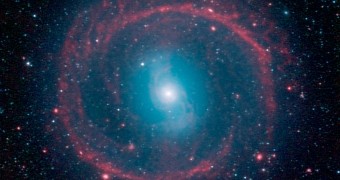Just a few days ago, NASA released an image documenting the anatomy of an ancient galaxy located at a considerable distance from our planet. The image, available next to this article, might look somewhat familiar to some people.
Thus, many agree that, all things considered, it's safe to say that this old galaxy sort of looks like the Eye of Sauron. And, yes, it's perfectly OK to want to watch the “Lord of the Rings” after having a look at this space image.
Studying the odd-looking distant galaxy
Information shared with the public by NASA astronomers shows that this positively stunning image, taken in infrared light, was obtained with the help of the Spitzer Space Telescope, which was launched into space quite a while ago, in 2003.
The galaxy featured in it is known to the scientific community as NGC 1291. It sits at a distance of about 33 million light-years from our planet, and scientists estimated that it formed some 12 billion years ago.
As detailed by the astronomers who have had the chance to study NGC 1291's anatomy, the galaxy's core appears colored in blue in this Spitzer Space Telescope image due to the fact that it chiefly comprises old stars.
The galaxy's outer ring, on the other hand, is just now in the process of birthing new stars. Hence, the infrared light image shows it colored in bright red. As noticeable in the image, the newborn stars in the outer ring are circling the galaxy's core.
Commenting on the rather peculiar anatomy of this distant galaxy, scientist Kartik Sheth with the National Radio Astronomy Observatory of Virginia said, “The rest of the galaxy is done maturing. But the outer ring is just now starting to light up with stars.”
How did NGC 1291 end up looking like this?
According to NASA astronomers, this galaxy and others of its kind owe their anatomy to a so-called central bar, which is basically an elongated core structure that is made of stars and that influences the movement of both interstellar gas and other stars.
It is believed that, when NGC 1291 was in its early years, this bar supported star formation processes close to the galaxy's core by causing interstellar gas to build up in this region. In time, the same bar triggered star formation processes in the galaxy's outer ring.
“The bars are a natural product of cosmic evolution, and they are part of the galaxies' endoskeleton. Examining this endoskeleton for the fossilized clues to their past gives us a unique view of their evolution,” researcher Kartik Sheth said in a statement, as cited by Space.
Interestingly enough, astronomers say that the Milky Way, which is our home galaxy, also packs a central bar of stars at its core. Hence, it is expected that, by studying NGC 1291, scientists will gain a better understanding of our own place in the universe.

 14 DAY TRIAL //
14 DAY TRIAL //